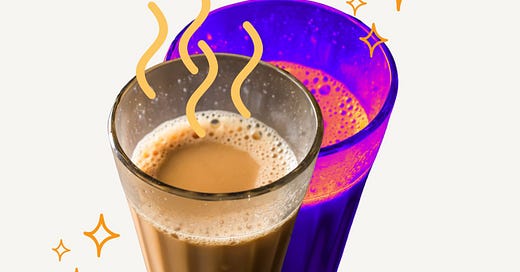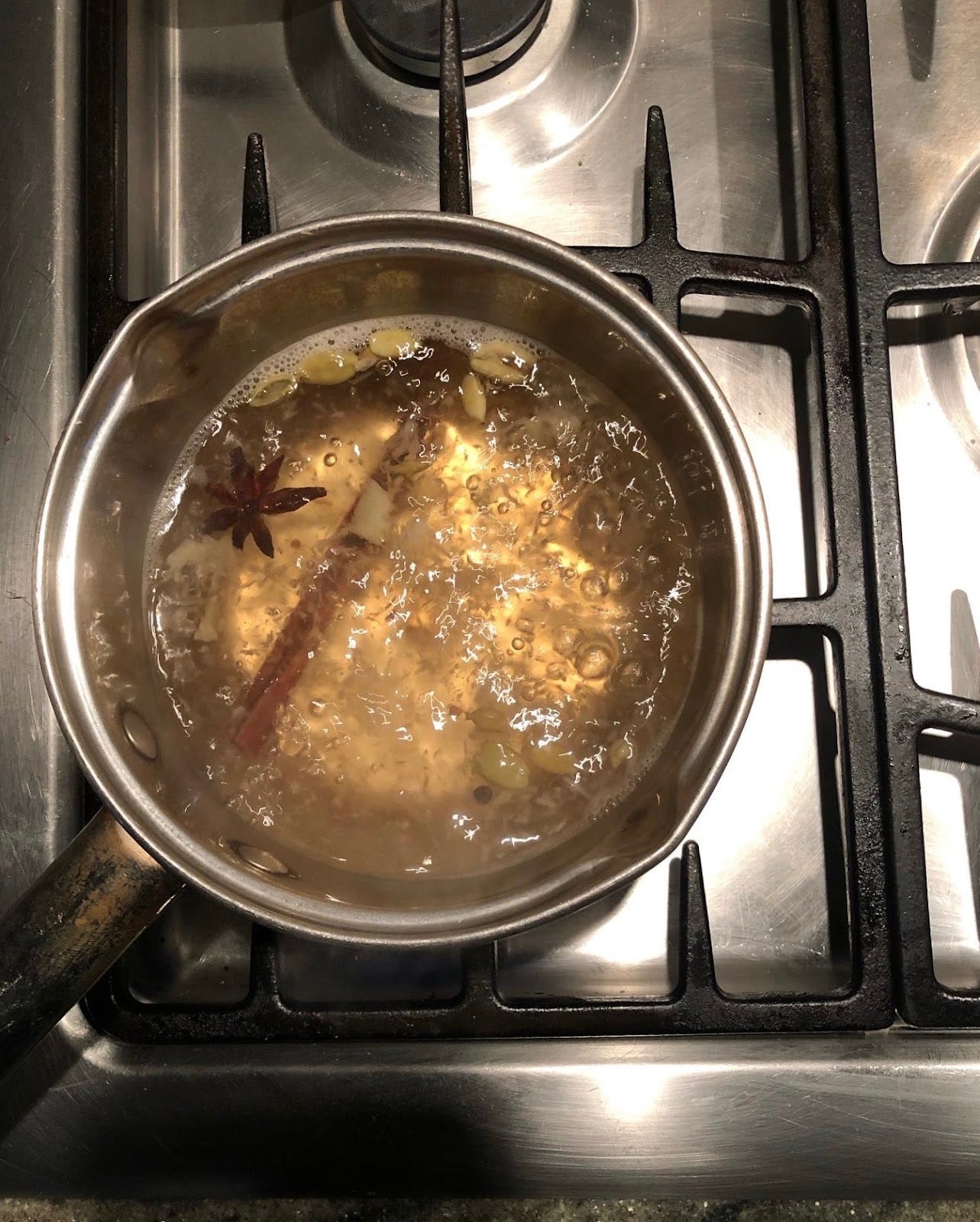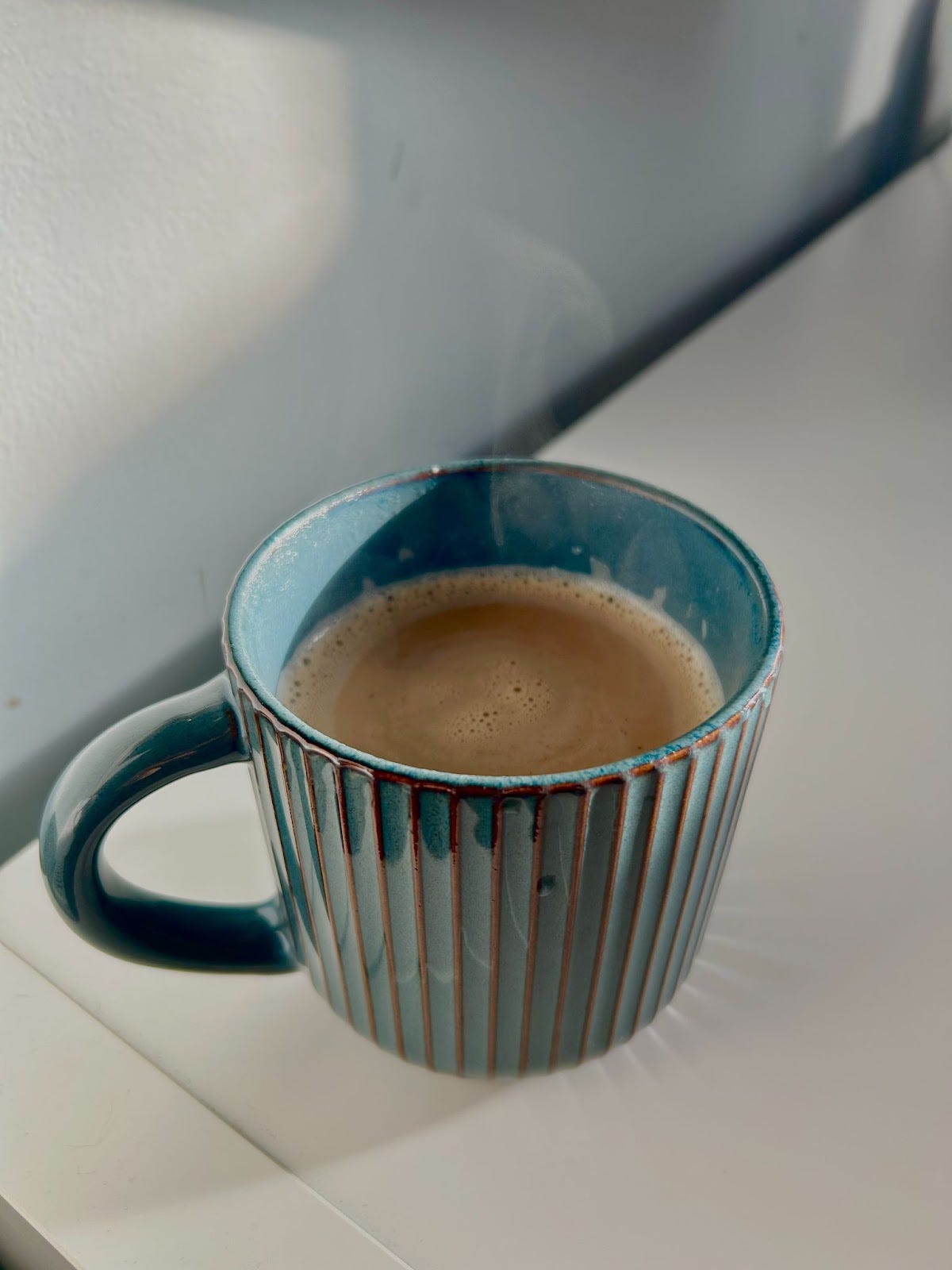Note from MILK
As some of you may know, we have been hosting a monthly supper club called "Tales From The Kitchen," where one of our community members makes a delicious meal and shares a bit about themselves and their culture. We've had Sakina sharing a Sudanese meal, and last month, Fathia shared a Moroccan meal. This month's and final "Tales from The Kitchen" will be on the 18th of March, my mum is joining us from West Yorkshire to cook a Southern Sri Lankan meal. Email us at hellomilkcafe@gmail.com to sign up!
Recently, I've noticed people coughing and sneezing everywhere. So, in addition to taking my vitamin C, I've also been chugging chai, hoping that it will cure me from it all, and I think it’s working (touch wood!). With that said, we are excited to share this beautiful piece and chai recipe written by Naaz, who initially joined us as a peer-writer and has been coming to our Friday morning conversations for the past few weeks.
Enjoy!
Gaar De Cha, Gaar ki Chai: In a world of ‘Chai Tea Lattes’
Written by Naaz
Chai/Chaa is a shared cup of happiness that originates across the Southern regions of Asia and is now loved all around the world. Each group, region, country, and family has their own twist on the centuries-old tea recipe. Chaa/Chai simply translates to tea. Cha has always been an integral part of South Asian culture, however, it was extremely affected, and still is by the echoes of colonial ideology.
Since the early 19th century, there has been a continuous evolution of culture surrounding tea, in recent decades there has been trends surrounding ‘Chai’ specifically. Originally Chai has been an affordable and accessible beverage amongst South Asia, but with recent branding, and consumer culture especially in the West accessibility and coffee shops, “chai tea” is often centred around gentrified versions of the beverage.
Although a Starbucks Chai Tea Latte can be nice, in efforts to boycott for our Palestinian brothers and sisters, decolonize, and create accessibility around the drink, I would like to share my family's recipe for making Chai. Gaar De Chaa means ‘homes tea’, for most Panjabis the day is not complete without a few cups of Chaa.
The first time I remember having Chaa was on my trip to Punjab during Lorhi season in the cold New Year of 2007. I vividly remember the foggy dusk before sunrise after morning prayer, watching my Beeji take two steel glasses moving the hot liquid from one cup to other to cool it down, creating a layer of sweet milky froth before sitting down with me on the manjee (a traditional South Asian style futon style bed) to share Chaa with cake rusk and Parle-G biscuits.
In my home and family, Chaa has always been a welcome and created a safe space. It is served when we have family, friends, and guests over or after a long day in the evening alongside snacks, good conversation, and an old Panjabi film. Every morning when I lived in my parents' house, during the winter months especially, the aroma of ginger, cinnamon, and other spices fills the house, like a blanket in the cold. Ginger is not used all year around in our tea and my family, mainly in the winter as it allows to warm the insides. For us Chaa is medicine. We’ve never really had formal recipes for Chaa in my house, it changes according to the weather, day, and occasion but this article has allowed me to be mindful and really pay attention to the process of making Chaa and the small things it brought to my home such as the aromas and warmth.
Chaa Recipe (Servings: 2-3)
What you need: Small or Medium pot, Mugs or Steel Glasses, Strainer, spoon
Ingredients:
Cinnamon power (half a tea spoon or to taste) or 1 Cinnamon Stick ਦਾਲਚੀਨੀ/دار چینی
4 Elachi (Green cardamom) or to taste ਇਲਾਇਚੀ /الائچی
4 Laug (Cloves) or to taste ਲੌਂਗ /ونگ
½ inch block of fresh Adaraka (Ginger) crushed before adding or half a tea spoon of ginger power, or to taste (tip, crushed ginger allows for the infusing process to happen easily) ਅਦਰਕ /ادرک
3 Chaa Pati, Black tea bags or lose leaf black tea, ਚਾਹ / چائے
Sugar to taste (around three spoons should do the trick if you like it sweet) ਖੰਡ / شکر
Milk (whole milk or skimmed milk or cashew milk)
Water
Optional Ingredients
2 to 4 Saffron strings ਕੇਸਰ / زعفران
1 Kali Mirch, Black Peppercorn ਕਾਲੀ ਮਿਰਚ / کالی مرچ
1 or 2 Badian Khatai, Star Anise ਸਟਾਰ ਸੌਂਫ / بادیانی
Steps
In a small or medium pot add Elachi (Green Cardamom, be sure to open the pods before adding), 4 Laug (Cloves), Crushed Adaraka (ginger), Cinnamon (and optional spices) along with 3 to 3 ½ cups of water. Place on stove at medium to high heat and boil until water has gone down to around two cups.
At this point there should be a strong aroma of the spices. Once the water has gone down to about two cups, you will have created a constraint with your spices and you can now go ahead and thrown in the Chaa Pati, Black tea bags or Lose Black Tea.
Continue boiling on low to medium for 10-15 more minutes and then add in two or three cups of milk depending on how creamy you like it, after this step its important to stay close to the Chaa as the milk can boil out of the pot. Depending on how hot you like your drink, you can boil the milk, however, I like to standby and listen as a milk starts to reach a boiling point and stop it before it does.
Once done pour into mugs, and add sugar to taste. (Tip, brown sugar taste the best!) You may also use honey or alternative sweeteners such as agave.
Enjoy you Gaar De Chaa :)
(Tip; Chaa taste great with Barfi, Parle-G biscuits, Butter Cookies or Cake Rusk)
Naaz is a spoken word poet and a MSc student at the University of Glasgow. She is a new resident of Scotland, and comes from the Canadian Punjabi diaspora. Her work is focused on her lived experiences and community ties, passionately crafting words, art, and advocacy together.
Kim Supajirawatananon and Shakya Seresinghe act as the overall contributors for the blog, pitching article ideas, putting together articles, posting, and making small edits. We also run a peer-writers project on the side, where creatives from the wider community support the blog through editing, interpreting, translating etc. This blog is a collective effort, and we thank everyone for their contributions.
All our content is free. If you can, we ask you to consider making a small pledge so we can compensate the contributors in small ways.
Thank you very much.









